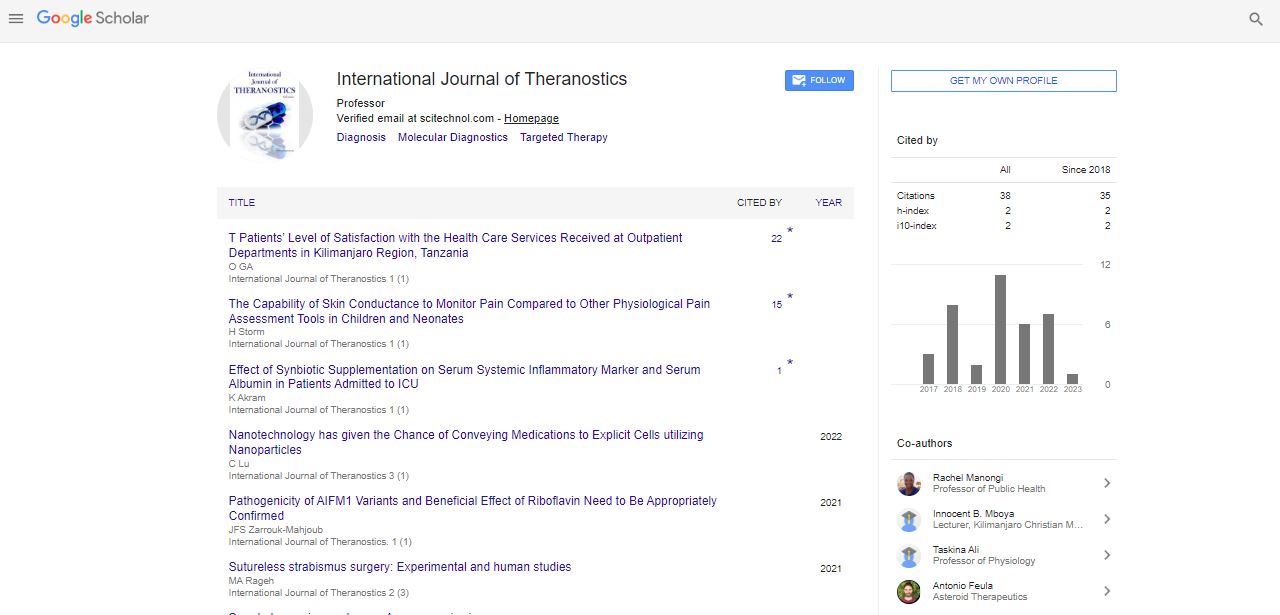Perspective, Int J Theranostic Vol: 12 Issue: 4
Immunotherapy and Theranostics: The Innovation of Precision Medicine Convergence
Ricardo Vilin*
1Department of Medicine, Universidade Federal de Minas Gerais, Belo Horizonte, Brazil
*Corresponding Author: Ricardo Vilin,
Department of Medicine, Universidade
Federal de Minas Gerais, Belo Horizonte, Brazil
E-mail: Vilricardo678@jufmg.br
Received date: 27 November, 2023, Manuscript No. IJT-23-124055;
Editor assigned date: 29 November, 2023, PreQC No. IJT-23-124055 (PQ);
Reviewed date: 14 December, 2023, QC No. IJT-23-124055;
Revised date: 21 December, 2023, Manuscript No. IJT-23-124055(R);
Published date: 28 December, 2023, DOI: 10.4172/IJT.1000143.
Citation: Vilin R (2023) Immunotherapy and Theranostics: The Innovation of Precision Medicine Convergence. Int J Theranostic 12:5.
Description
The convergence of immunotherapy and theranostics represents a Innovative frontier in the field of medical science. Immunotherapy harnesses the body's own immune system to combat diseases, particularly cancer, while theranostics integrates diagnostics and therapeutics for precise, personalized treatment. This essay explores the intersection of immunotherapy and theranostics, highlighting the development of immune-based diagnostics and targeted therapies that hold immense promise in reshaping the landscape of precision medicine.
Immunotherapy has emerged as a transformative approach to treating a variety of diseases, with a particular emphasis on cancer. Unlike traditional treatments such as chemotherapy or radiation, which directly target cancer cells, immunotherapy stimulates the body's immune system to recognize and eliminate abnormal cells. The fundamental premise is to enhance the immune response, turning the body into a powerful ally against diseases.
Checkpoint inhibitors are a prominent class of immunotherapies that target proteins involved in immune regulation, such as programmed cell Death Protein 1 (PD-1) and Cytotoxic TLymphocyte- Associated Protein 4 (CTLA-4). By blocking these checkpoints, which act as brakes on the immune system, checkpoint inhibitors unleash the immune response against cancer cells. Drugs like pembrolizumab and ipilimumab have demonstrated remarkable success in various malignancies.
Chimeric Antigen Receptor T-cell therapy (CAR-T) involves genetically modifying a patient's T cells to express receptors specific to cancer cell antigens. Once infused back into the patient, these engineered T cells can recognize and destroy cancer cells with precision. CAR-T therapies, such as Kymriah and Yescarta, have shown remarkable efficacy, particularly in hematologic malignancies.
Cancer vaccines aim to stimulate the immune system to recognize and attack cancer cells. Therapeutic cancer vaccines, like Sipuleucel-T for prostate cancer, work by training the immune system to target cancer-specific antigens. Preventive cancer vaccines, such as those targeting Human Papillomavirus (HPV) or hepatitis B, aim to reduce the risk of cancer development.
While immunotherapy has demonstrated significant success, its efficacy can vary among individuals. This variability highlights the importance of developing immune-based diagnostics that can identify patients likely to respond to specific immunotherapies. Precision diagnostics help guide treatment decisions, ensuring that patients receive therapies with the highest likelihood of success while minimizing potential side effects.
Identifying predictive biomarkers is crucial for tailoring immunotherapy to individual patients. For example, the expression of Programmed Death-Ligand 1 (PD-L1) in tumor cells has been associated with better responses to PD-1/PD-L1 checkpoint inhibitors. Biomarker testing, often performed through immunohistochemistry or molecular assays, assists clinicians in selecting the most appropriate immunotherapeutic agents for their patients.
Next-generation sequencing and genomic profiling play a vital role in understanding the molecular landscape of tumors. Tumor Mutational Burden (TMB) and Microsatellite Instability (MSI) are genomic markers associated with increased responsiveness to immunotherapy. Integrating genomic data into diagnostics allows for a comprehensive assessment of a patient's tumor and aids in predicting the likelihood of a positive response to immunotherapeutic interventions.
Liquid biopsies, which analyze circulating tumor DNA (ctDNA) and other biomarkers in blood samples, offer a non-invasive means of monitoring treatment response and disease progression. Liquid biopsies are particularly valuable in situations where obtaining tissue samples may be challenging. Monitoring changes in ctDNA levels can provide real-time insights into the evolving landscape of the disease and guide treatment adjustments.
Theranostics, the integration of diagnostics and therapeutics, is a natural ally to immunotherapy. By combining precise diagnostics with targeted therapeutic interventions, theranostics maximizes treatment efficacy while minimizing adverse effects. This convergence is particularly relevant in the context of immunotherapy, where understanding the dynamic interplay between the immune system and the disease is essential for optimizing patient outcomes.
Advanced imaging techniques, such as Positron Emission Tomography (PET) and Single-Photon Emission Computed Tomography (SPECT), play a crucial role in assessing immune responses and treatment efficacy. Immuno-PET, for instance, involves the use of radiolabeled antibodies or immune checkpoint inhibitors to visualize immune cell infiltration in tumors. These imaging modalities provide valuable insights into the spatial distribution of immune cells within the tumor microenvironment.
Nanotechnology offers innovative solutions in the realm of immunotheranostics. Nanoparticles can serve as both diagnostic agents and drug delivery vehicles, enabling targeted delivery of immunotherapeutic agents to specific sites. Functionalized nanoparticles can carry imaging agents to visualize immune responses and deliver immunomodulatory drugs directly to the tumor, enhancing treatment precision.
Companion diagnostics are integral to the successful implementation of immunotherapies. Identifying patients who are most likely to benefit from specific immunotherapeutic interventions requires the development of companion diagnostic tests. For example, the approval of pembrolizumab for PD-L1-positive tumors emphasizes the importance of companion diagnostics in guiding treatment decisions.
While the intersection of immunotherapy and theranostics holds tremendous promise, several challenges must be addressed for widespread clinical implementation. Tumor heterogeneity poses a significant challenge in tailoring immunotherapies to individual patients. The dynamic nature of tumors and the emergence of resistant cell populations necessitate ongoing monitoring and adaptation of treatment strategies. Incorporating evolving diagnostic techniques and molecular profiling into routine clinical practice is essential to address tumor heterogeneity effectively.
 Spanish
Spanish  Chinese
Chinese  Russian
Russian  German
German  French
French  Japanese
Japanese  Portuguese
Portuguese  Hindi
Hindi 